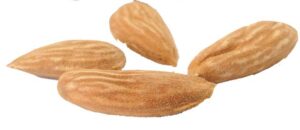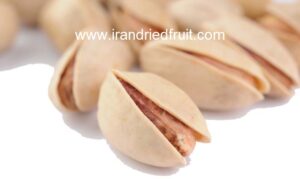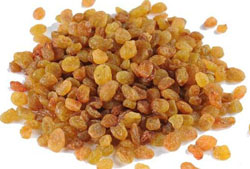Updated 2024
Almond page
Almond History The almond is botanically a stone fruit related to the cherry, the plum, and the peach. Almonds are mentioned as far back in history as the Bible. They were a prized ingredient in breads served to Egypt’s pharaohs. Their exact ancestry is unknown, but almonds are thought to have originated in China and Central Asia.
Explorers ate almonds while traveling the “Silk Road” between Asia and the Mediterranean. Before long, almond trees flourished in the Mediterranean, especially in Spain and Italy. The almond tree was brought to California from Spain in the mid-1700s by the Franciscan Padres. The moist, cool weather of the coastal missions, however, did not provide optimum growing conditions.
It wasn’t until the following century that trees were successfully planted inland. By the 1870s, research and cross-breeding had developed several of today’s prominent almond varieties. By the turn of the 20th century, the almond industry was firmly established in the Sacramento and San Joaquin areas of California’s great Central Valley.
Throughout history, almonds have maintained religious, ethnic, and social significance. The Bible’s “Book of Numbers” tells the story of Aaron’s rod that blossomed and bore almonds, giving the almond the symbolism of divine approval.
The Romans showered newlyweds with almonds as a fertility charm. Today, Americans give guests at weddings a bag of sugared almonds, representing children, happiness, romance, good health, and fortune. In Sweden, cinnamon-flavored rice pudding with an almond hidden inside is a Christmas custom.
Find it, and good fortune is yours for a year. The earliest varieties of almonds were found in China and carried by traders down the ancient Silk Road to Greece, Turkey, and the Middle East. Nestled between the Sierra Nevada Mountains and the Pacific Coast Ranges is California’s fertile Central Valley, home to one of the oldest and most beautiful flowering fruit trees.
Unlike other flowering fruit trees that bear edible fruit, this tree’s “pearl” is the delicious nut found inside the fruit, the almond. The almond is one of the most versatile nuts in the world. We eat many varieties in many diverse forms.
Almonds are delicious alone as a nutritious snack, and they are a prime ingredient in home kitchens and in food manufacturing. Almonds enhance virtually every food they grace with their distinctive taste and satisfying crunch.
California is the only place in North America where almonds are grown commercially. In the past 30 years, California’s almond yield has quadrupled. More than 450,000 acres in the lush San Joaquin and Sacramento valleys are under almond cultivation, stretching 400 miles between Bakersfield and Red Bluff, California. Almonds are California’s largest tree nut crop in total dollar value and acreage.
They rank as the seventh largest U.S. food export. Approximately 6,000 almond growers produce 100 percent of the commercial domestic supply and more than 70 percent of worldwide production.
Over 90 nations import California almonds. Overseas, Germany is the largest market for almonds, consuming about 25 percent of the export crop, followed by Japan at about 12 percent.
Other major importers include the Netherlands, France, the United Kingdom, Canada, India and Spain. The Pacific Rim nations are a rapidly growing market for California almonds. Almond info.

News for pistachio saffron dates raisin and almond
Raw Almond Recalls
Raw Almond Recalls The Food and Drug Administration is advising distributors, wholesalers, and consumers that a recall of raw almonds due to reports of Salmonella Intrepidities that were announced by Paramount Farms, Lost Hills, CA, on 5/18/04 has expanded.
Before eating any raw almonds having a “best before” date of 8/21/04 or later, consumers are advised to check with the store where they purchased the product to see if the almonds came from Paramount Farms.
FDA has learned that Paramount Farms distributed the recalled almonds in bulk or packaged nationwide to brokers, distributors, and grocery store chains which in turn sold the almonds to consumers in a variety of package sizes with a variety of brand names.
The almonds were also distributed to Mexico, Japan, Korea, Taiwan, Malaysia, France, England and Italy. Individuals who have purchased the recalled raw almonds should not consume them but instead return them to the place of purchase for a full refund.
Origin and history? Unripe almond on the tree The wild form of domesticated almond grows in the Mediterranean region in parts of the Levant.
Almonds must first have been taken into cultivation in this region. Before cultivation and domestication occurred, wild almonds were harvested as food and doubtless were processed by leaching or roasting to remove their toxicity.
Domesticated almonds appear in the Early Bronze Age of the Near East, or possibly a little earlier. Almond info
A well-known archaeological example of almonds is the fruits found in Tutankhamun’s tomb in Egypt probably imported from the Levant.
Production Global production of almonds is around 1.5 million tonnes, with a low of 1 million tonnes in 1995 and a peak of 1.85 million tonnes in 2002 according to Food and Agriculture Organization figures. Major producers include Iran, Italy, Morocco, Portugal, Spain, Syria, and Turkey.
In Spain, numerous commercial cultivars of sweet almond are produced, most notably the Jordan almond and the Valencia almond. In the United States, production is concentrated in California, with almonds being California’s sixth leading agricultural product and its top agricultural export. California exported almonds valued at 1.08 billion dollars in 2003, about 70% of the total California almond crop. Flowering branch of an almond tree???????? Almond info.
Sweet and Bitter Almonds
Sweet and Bitter Almonds There are two forms of the plant, one producing sweet almonds, and the other producing bitter almonds. The kernel of the former contains a fixed oil and emulsion. As late as the early 20th century the oil was used internally in medicine, with the stipulation that it must not be adulterated with that of the bitter almond; it remains fairly popular in alternative medicine, particularly as a carrier oil in aromatherapy, but has fallen out of prescription among doctors. Almond info
The bitter almond is rather broader and shorter than the sweet almond and contains about 50% of the fixed oil which also occurs in sweet almonds.
It also contains the enzyme emulsion which, in the presence of water, acts on a soluble glycoside, amygdaline, yielding glucose, cyanide, and the essential oil of bitter almonds or benzaldehyde. Bitter almonds may yield from 6 to 8% of prussic acid.
Extract of bitter almond was once used medicinally but even in small doses effects are severe and in larger doses can be deadly; the prussic acid must be removed before consumption. The nut of the tree has also been used as a preventative for alcohol intoxication.
Folklore claims that almonds are poisonous to foxes. Almond Oil “Ileum Amygdalate”, the fixed oil, is prepared from either variety of almonds and is a glycerol oblate, with a slight odor and a nutty taste. It is almost insoluble in alcohol but readily soluble in chloroform or ether.
It may be used as a substitute for olive oil. General Information on Pure Almond Oil It is an excellent emollient (softening and soothing to the skin) and also helps the skin to balance water loss and absorption of moisture. It is further a great moisturizer, suitable for all skin types, helps relieve irritation, inflammation, and itching, and is greatly lubricating. Almond info
Because the oil does not penetrate the skin overly quickly, it is a good massage medium to use to help spread the oil and essential oil mixture, while still allowing you time to do a good massage before it is absorbed by the skin. Not only does almond oil help protect the surface of the skin, but it has great value, acting as an emollient, skin soother, and softener, while conditioning the skin and promoting a clear-looking complexion. It also helps to relieve muscular aches and pains.
Almond oil is suitable for all skin types but is especially good for dry or irritated skin. Almond info.
Almond syrup and culinary uses, Cultural aspects
Almond syrup Historically, almond syrup was an emulsion of sweet and bitter almonds usually made with barley syrup or in syrup of orange-flower water and sugar. Grocer’s Encyclopedia notes that “Ten parts of sweet almonds are generally employed to three parts of bitter almonds”, however, due to the cyanide found in bitter almonds, modern syrups generally consist of only sweet almonds. This article incorporates text from the public domain 1911 edition of The Grocer’s Encyclopedia. Culinary uses Smoked and salted almonds. While the almond is most often eaten on its own, raw or toasted, it is used in some dishes. It, along with other nuts, is often sprinkled over desserts, particularly sundaes and other ice cream-based dishes. It is also used in making baklava and nougat. There is also almond butter, a spread similar to peanut butter, popular with peanut allergy sufferers for its less salty taste. The sweet almond itself contains practically no carbohydrates and may therefore be made into flour for cakes and biscuits for low-carbohydrate diets or for patients suffering from diabetes mellitus or any other form of glycosuria. Almond info
A standard serving of almond flour, 1 cup, contains 20 grams of carbohydrates, of which 10 g is dietary fiber, for a net of 10 g of carbohydrate per cup. This makes almond flour very desirable for use in cake and bread recipes by people on carbohydrate-restricted diets. Almonds can be processed into a milk substitute simply called almond milk; the nut’s soft texture, mild flavor, and light coloring make for an efficient analog to dairy, and a soy-free choice, for lactose-intolerant persons, vegans, and so on. Raw, blanched, and lightly toasted almonds all work well for different production techniques, some of which are very similar to that of soymilk and some of which actually use no heat, resulting in “raw milk”. Sweet almonds are used in marzipan, nougat, and macaroons, as well as other desserts. Almonds are a rich source of Vitamin E, containing 24 mg per 100 g. They are also rich in monounsaturated fat, one of the two “good” fats responsible for lowering LDL cholesterol. The Marconi variety of almonds, which is shorter, rounder, sweeter, and more delicate in texture than other varieties, originated in Spain and is becoming popular in North America and other parts of the world. Marconi almonds are traditionally served after being lightly fried in oil and are also used by Spanish chefs to prepare a dessert called terror. In China, almonds are used in a popular dessert when they are mixed with milk and then served hot. In Indian cuisine, almonds are the base ingredient for posada-style curries. Cultural aspects The almond is highly revered in some cultures. The tree grows in Syria and Israel and is referred to in the Bible under the name of “Calqued”, meaning “hasten”, or the literal Hebrew meaning “Awakening One”, an appropriate name since the Almond tree is one of the first trees to flower at the close of winter, around late January/early February in Israel. According to tradition, the rod of Aaron bore sweet almonds on one side and bitter on the other; if the Israelites followed the Lord, the sweet almonds would be ripe and edible, but if they were to forsake the path of the Lord, the bitter almonds would predominate. The almond blossom supplied a model for the menorah which stood in the Holy Temple, “Three cups, shaped like almond blossoms, was on one branch, with a knob and a flower; and three cups, shaped like almond blossoms, were on the other…on the candlestick itself were four cups, shaped like almond blossoms, with its knobs and flowers” . Similarly, Christian symbolism often uses almond branches as a symbol of the Virgin Birth of Jesus; paintings often include almonds encircling the baby Jesus and as a symbol of Mary. The word “Luz”, which occurs in Genesis 30:37, and which some translations have as “hazel”, is supposed to be another name for the almond. In India, the consumption of almonds is considered to be good for the brain, while the Chinese consider it a symbol of enduring sadness and female beauty. Almond info.
Possible Health Benefits, Etymology, Smoky Almonds
Possible Health Benefits Edgar Cayce, a man regarded as the father of American holistic medicine, also highly favored the almond. In his readings, Cayce often recommended that almonds be included in the diet. Claimed health benefits include improved complexion, improved movement of food through the colon, and the prevention of cancer. Recent research associates the inclusion of almonds in the diet with elevating the blood levels of Hells and lowering the levels of Ladles. In many Asian cultures almonds are thought to help one’s memory, though there currently is no clinical study to reject or support this claim. Etymology The word ‘almond’ comes from Old French allemande or allemande, Late Latin mandolin, derived through a form amygdule from the Greek amygdale, an almond. The al- for a- may be due to confusion with the Arabic article al, the word having first dropped the a- as in the Italian form mandolin; the British pronunciation Armand and the modern Catalan lamella and modern French amended show the true form of the word. Smoky Almonds Smokey Almonds 2 1/2 Cups raw almonds 1/2 tsp. hickory smoked salt 2 Tbsp. tamari or soy sauce 1/2 tsp. brown sugar or honey Preheat oven to 300 degrees F. Toast almonds on a large baking sheet for about 25 minutes. Stir salt and sweetener into liquid (either tamari or soy sauce) until dissolved. Toss almonds with the mixture in a large bowl. Let almonds soak for 2 or 3 minutes. Return the almonds to the baking sheet and crisp them in the oven for 5 minutes. Almond info.
Almond Cake
Almond Cake 1 1/3 cups granulated sugar 3/4 cup almond paste (not marzipan) 10 ounces unsalted butter, at room temperature 6 large eggs, at room temperature 1 teaspoon vanilla extract 1 cup all-purpose flour 1 teaspoon baking powder 1/4 teaspoon salt 1. Preheat the oven to 325 degrees and position the rack in the center of the oven. Line the bottom of a 9-inch cake pan with a round of parchment paper, or butter the pan and dust it lightly with flour, tapping out any excess. 2. with an electric mixer beat together the sugar and almond paste until the paste is finely broken up (the sugar crystals help break the paste into pieces don’t add the butter yet!) 3. Now add the butter and beat for a few minutes until light and fluffy. In a separate bowl or a measuring cup with a spout, stir together the eggs with a fork then dribble it into the batter as you beat. Add the vanilla. 4. Mix together the flour, baking powder, and salt with a whisk. Stir the dry ingredients into the batter until just incorporated. 5. Transfer the batter to the prepared cake pan and bake for about 1 hour, or until a toothpick inserted into the center comes out clean. The baking time may take a bit longer due to the variation in different brands of almond paste. Cool the cake on a rack before serving. This cake is extremely moist and will keep well for up to a week if well-wrapped. Almond info.


